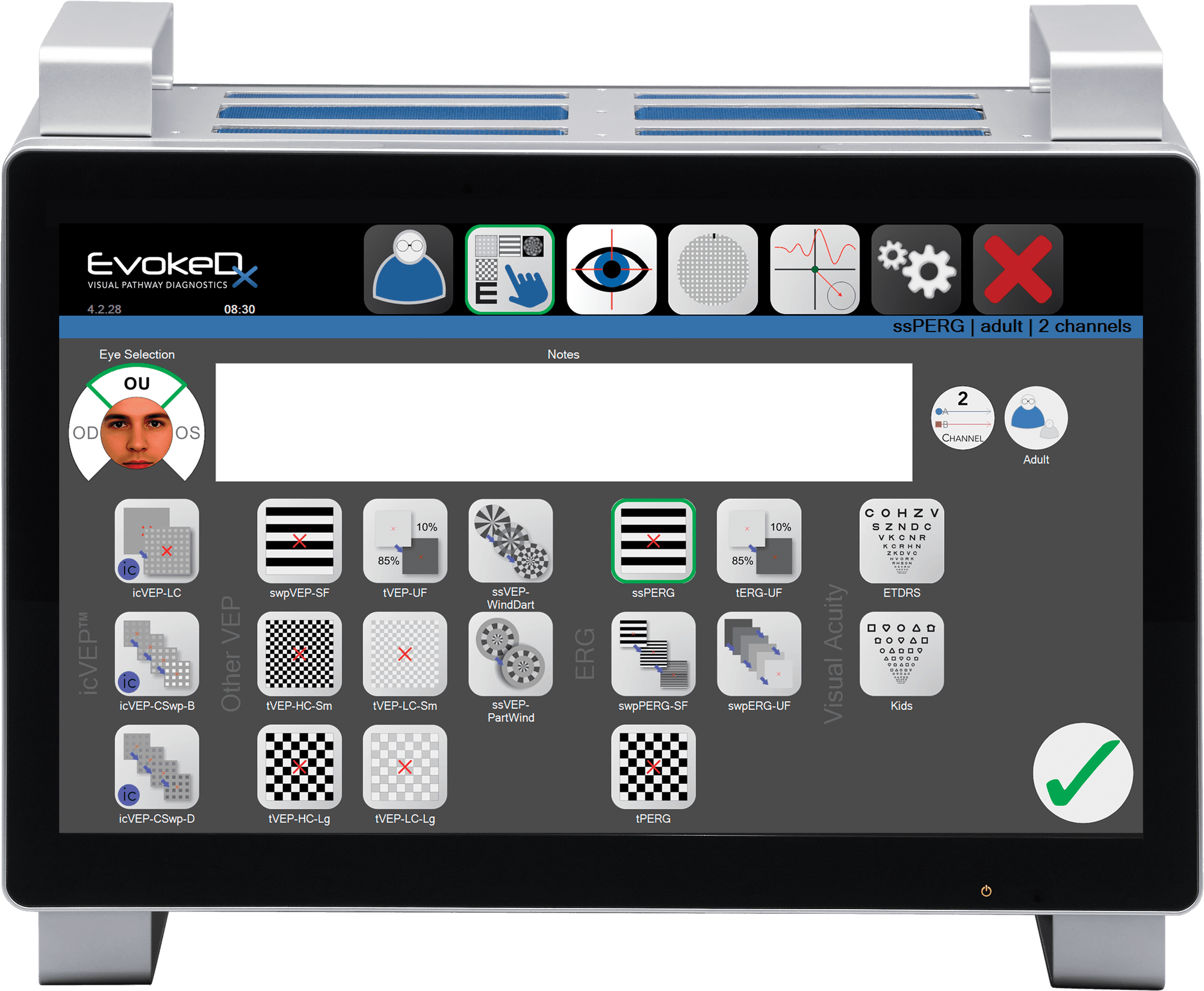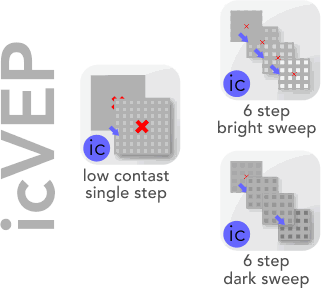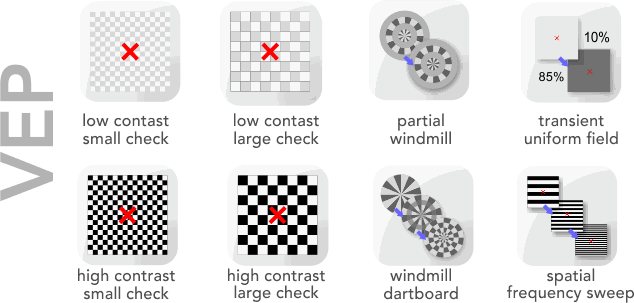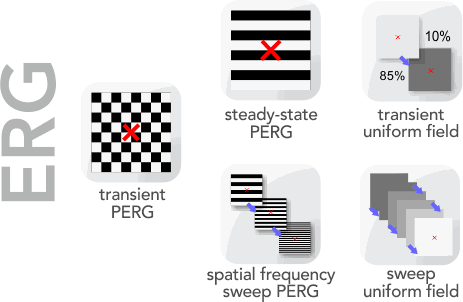
icVEP™: Isolated-check Visual Evoked Potential
EvokeDx uniquely features icVEP, a proprietary test strategy based upon studies designed to emphasize contributions to the VEP selectively from the ON or OFF subdivisions of the magnocellular neural pathways¹.

icVEP Bright & Dark Check Patterns
Contrast / luminance of non-contiguous checks varies sinusoidally rapidly in time such that the pattern smoothly appears and then disappears. The low contrast, bright-check pattern modulated at high frequency, is thought to emphasize the M-ON pathway. icVEP tests are designed to assess low contrast processing in the visual system, which is deficient in glaucoma [5]. In a multi-site, NIH-funded study, the icVEP strategy demonstrated high classification accuracy for early-stage glaucoma, Phase I [6] (A’=94%), Phase II [7] (A’=89.2%).
Sweep versions of this test, either with steps of increasing contrast of bright checks or increasing contrast of dark checks characterize the range of low contrast vision response affected, with the final steps also including a high contrast response (thought to involve the Parvocellular pathway).
This contrast-sweep icVEP technique was applied to a study of schizophrenia and autism which discovered selective deficits in visual processing. Selective low-contrast deficits were found using this technique in a study of patients with retinitis pigmentosa as well[8].
VEP: Visual Evoked Potential
EvokeDx includes a spatial frequency sweep VEP, ISCEV standard transient VEPs (high and low contrast reversing checkerboard), and novel VEP tests unique to EvokeDx; steady-state Windmill Dartboard and Partial Windmill Dartboard.

ERG: Electroretinogram
Electroretinography or electroretinograms (ERG) is an important clinical tool that provides an objective quantitative measure of retinal function. ERGs elicited by patterned stimuli (PERGs) reflect the activity of the inner retina (primarily retinal ganglion cells) whereas ERGs resultant from luminance modulation of a uniform field taps activity of the outer retina (primarily ON-bipolar cells).

It follows that ERG tests assess various types of visual function responses prior to modification/processing by neurons in the brain. EvokeDx features a dual-channel amplifier and a five electrode ERG cable that enables binocular ERG recording, cutting ERG test time in half when compared to single-channel, three-electrode systems.

[2] Zemon, V., Eisner, W., Gordon, J., Grose-Fifer, J., Tenedios, F., & Shoup, H. (1995). Contrast-dependent responses in the human visual system: childhood through adulthood. International Journal of Neuroscience, 80(1-4), 181-201.
[3] Dacey, D. M., & Petersen, M. R. (1992). Dendritic field size and morphology of midget and parasol ganglion cells of the human retina. Proceedings of the National Academy of sciences, 89(20), 9666-9670.
[4] Yeh, C. I., Xing, D., & Shapley, R. M. (2009). “Black” responses dominate macaque primary visual cortex v1. The Journal of Neuroscience, 29(38), 11753-11760.
[5] Greenstein, V. C., Seliger, S., Zemon, V., & Ritch, R. (1998). Visual evoked potential assessment of the effects of glaucoma on visual subsystems. Vision research, 38(12), 1901-1911.
[6] Zemon, V., Tsai, J. C., Forbes, M., Al-Aswad, L. A., Chen, C. M., Gordon, J., … & Jindra, L. F. (2008). Novel electrophysiological instrument for rapid and objective assessment of magnocellular deficits associated with glaucoma. Documenta ophthalmologica, 117(3), 233-243.
[7] Nayak, N., Hu, G., Lin, J., Tsai, J., (2011). Utility of the Isolated-Check Visual Evoked Potential Technique as a Glaucoma Monitoring Device. ARVO, #5480.
[8] Alexander, K. R., Rajagopalan, A. S., Seiple, W., Zemon, V. M., & Fishman, G. A. (2005). Contrast response properties of magnocellular and parvocellular pathways in retinitis pigmentosa assessed by the visual evoked potential. Investigative Ophthalmology and Visual Science, 46(8), 2967-2973.
